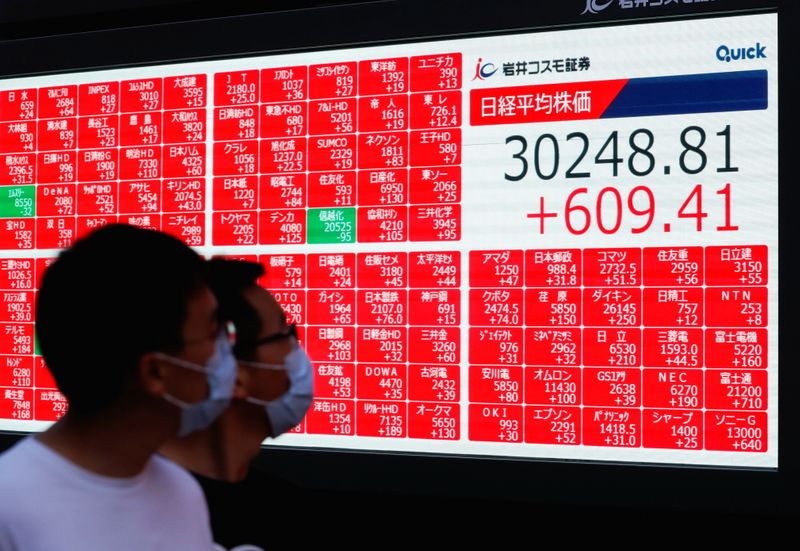Shares staunch bleed after worst selloff since January By Reuters

© Reuters. Men wearing protective face masks amid the coronavirus disease (COVID-19) outbreak look at an electronic board displaying Japan’s Nikkei Index outside a brokerage in Tokyo, Japan, September 24, 2021. REUTERS/Kim Kyung-Hoon
By Marc Jones
LONDON (Reuters) – Investors sought to staunch the bleed on Wednesday after world stocks suffered their worst rout since January, while U.S. and European borrowing costs raced to their highest in months.
Asia managed to slow the falls and the pan-European index bounced 1% in early trading after shedding 2.2% on Tuesday and after all three major Wall Street indexes suffered their steepest drops since mid-July. ()
The global benchmarks for borrowing costs – the yields on U.S. and German government bonds – edged lower, with traders waiting to hear from the heads of the European Central Bank, the U.S. Federal Reserve, Bank of Japan and Bank of England later.
“The question that will come in the next 10 days is will the U.S. Treasury yield keep pushing above 1.5%,” said Societe Generale (OTC:) strategist Kenneth Broux. “That was a sort of breaking point for broader risk assets when stops went off and the selloff started accelerating.”
Broux said the question for October and the rest of the year would be whether inflation pressures started to abate. “The 1.5% level (on U.S. Treasuries) is really pivotal,” he said.
In the currency markets, the run up in yields, prompted by signs the Fed wants to start cutting stimulus by the end of the year, saw the dollar touch an 18-month high against the yen and set its highest level of the year versus other major peers too.
Doubts are re-emerging about the global recovery at a time when the Fed is set to taper stimulus and the U.S. administration is stuck in debt ceiling talks that could lead to a government shutdown. China is also grappling with a power crunch that has hit its economic output.
MSCI’s broadest index of Asia-Pacific shares outside Japan fell 0.84% and was heading for a 9.4% decline for the third quarter, its worst quarterly performance since the first three months of 2020, when global markets were roiled by the initial spread of COVID-19.
World stocks are heading for their first red quarter since the peak of COVID panic, while the dollar is on course for its best year since 2015 and gas and energy prices have surged.
Coffee is up 25% for second quarter in a row. The Baltic Dry index of global freight prices has surged 40% to add to 50% and 65% rises in previous two quarters, while China’s woes have seen iron ore slump 45%, which will be its worst quarter on record.
“We still see inflation as a risk, but our base case is that it will be transitory and come back to more normal levels during next year,” said Osman Sattar, S&P Global (NYSE:)’s Director for EMEA Financial Institutions.
But companies face pressure on margins as higher energy prices are locked into next year’s bills.
ROTATE TO VALUE
U.S. Futures suggested a risk-friendlier mood could…
Read More: Shares staunch bleed after worst selloff since January By Reuters
